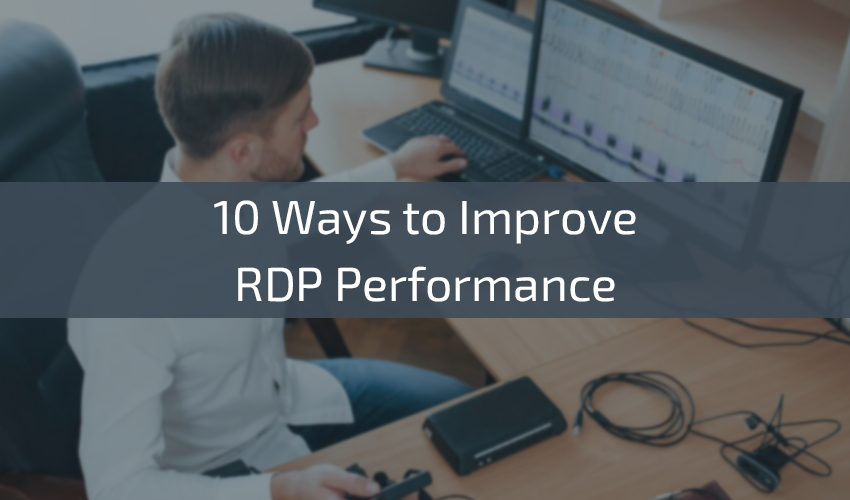Supercharge Your Remote Desktop Experience: 10 Ways to Improve RDP Performance. Remote Desktop Protocol (RDP) is an invaluable tool that allows you to connect to a remote computer or server from anywhere, facilitating remote work, IT support, and server management. However, a laggy and unresponsive RDP connection can be a major productivity roadblock. In this blog post, we will explore ten effective ways to improve RDP performance and ensure your remote desktop experience is seamless and efficient.
1. Optimize Your Network Connection
A stable and fast network connection is crucial for an effective RDP experience. Here’s how to optimize your network:
- Use Wired Connection: If possible, use a wired Ethernet connection instead of Wi-Fi, as it offers better stability and speed.
- Check Bandwidth: Ensure your internet plan provides sufficient bandwidth for your RDP needs, especially if you need to transfer large files.
- Quality of Service (QoS): Configure your router to prioritize RDP traffic using Quality of Service (QoS) settings, which can prevent other network activities from interfering with your RDP connection.
2. Choose the Right Server
The performance of your RDP sessions also depends on the remote server or computer you’re connecting to. Here are some considerations:
- Select a Well-Configured Server: Choose a remote server or computer with sufficient resources, including CPU, RAM, and storage. Overloaded servers can lead to slow RDP performance.
- Use a Server Close to Your Location: Opt for a remote server located closer to your physical location to minimize latency.
- Regular Server Maintenance: Ensure the remote server is well-maintained with the latest software updates and performance tuning.
3. Adjust Client Settings
Fine-tuning the settings on your local RDP client can significantly enhance the performance of your remote desktop sessions:
- Lower Display Settings: Reducing the screen resolution and color depth on your RDP client can reduce the amount of data transferred, improving performance.
- Disable Visual Effects: Turn off animations and visual effects in the Windows settings to reduce graphical demands on your RDP connection.
- Sound Quality Settings: Adjust audio quality settings to a lower quality or disable audio if it’s not necessary during your session.
4. Use RDP Compression
RDP supports various compression settings to reduce the data transferred over the network. Enabling compression can significantly improve RDP performance. To enable RDP compression:
- Open the Remote Desktop Connection application on your local machine.
- Click “Show Options” to access additional settings.
- Go to the “Experience” tab.
- Under the “Bitmap caching” section, select “Persistent bitmap caching” and adjust the “Persistent bitmap caching” slider to a suitable level.
5. Optimize Network Resources
Make sure that other applications and services on both your local and remote machines do not consume excessive network resources during your RDP sessions:
- Disable Automatic Updates: Prevent automatic updates on both your local and remote machines to avoid background downloads that can slow down your connection.
- Close Resource-Intensive Applications: Shut down resource-intensive applications on your local machine to free up processing power.
- Monitor Resource Usage: Use the Windows Task Manager to monitor resource usage and terminate unnecessary processes.
- Schedule Large Data Transfers: Schedule large file transfers or data backups for times when you’re not using RDP to avoid network congestion.
6. Upgrade Your Hardware
Upgrading your local machine’s hardware can significantly enhance your RDP performance, especially if you frequently use RDP for remote work or administration:
- Upgrade CPU, RAM, and Storage: An upgrade in these components will provide more processing power and storage space for your RDP sessions.
- Faster Network Card: Consider investing in a faster network card to ensure a stable and high-speed connection.
- Upgrade Your Router: A more powerful router can handle multiple devices competing for network resources.
7. Enable Network-Level Authentication (NLA)
Network-Level Authentication (NLA) is a security feature in RDP that can also enhance performance. To enable NLA:
- Open the Remote Desktop Connection application on your local machine.
- Click “Show Options” to access additional settings.
- Go to the “Advanced” tab.
- Under the “Connect from anywhere” section, select the “Network Level Authentication” option.
8. Use RemoteFX (if Applicable)
RemoteFX is a technology that enhances graphics and multimedia performance in RDP sessions. While it is typically used in Windows Server environments, enabling RemoteFX can improve the display quality and responsiveness in your RDP sessions. To enable RemoteFX:
- Open the Remote Desktop Connection application on your local machine.
- Click “Show Options” to access additional settings.
- Navigate to the “Display” tab.
- Under the “Remote Desktop Protocol” section, select “Highest quality (32-bit)” for color.
9. Keep Your RDP Client Updated
Regularly updating your RDP client ensures you’re using the latest version with bug fixes and performance improvements. Both Microsoft’s RDP client and third-party RDP clients, such as Remote Desktop Manager, release updates to enhance performance and security.
10. Test and Monitor Your Connection
To ensure consistent fast RDP performance, regularly test and monitor your connection. Use online tools or RDP performance monitoring software to check for network latency, packet loss, and other performance metrics. This proactive approach allows you to identify and address any issues before they affect your productivity.
Conclusion
A fast and responsive RDP connection is essential for productivity, whether you’re working remotely, managing servers, or providing IT support. By optimizing your network, adjusting client settings, and following these tips, you can significantly improve the speed and performance of your Remote Desktop sessions. Remember that the effectiveness of these techniques may vary depending on your specific network, hardware, and software configurations, so it may take some experimentation to find the ideal setup for your needs.

